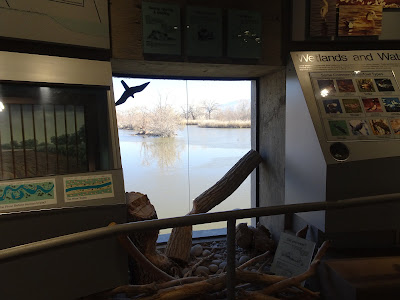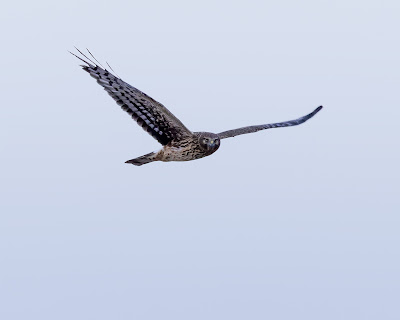We were up and checked out of our hotel early the next morning. The weather had gotten worse during the night and our car was showing 13 degrees. We started back to Sandia Crest for our last opportunity to see Rosy-Finches. The streets were slick and icy and, even in town, had not been plowed. We decided not to attempt going back up the mountain. It was disappointing to only see one of our target birds. Maybe next year we will try again.
Our next stop was a couple hours away. I love these giant
pots that are in the median.
The road to Socorro was clear. We did see some snow in the fields but the weather was much better than in Albuquerque.
We arrived at Bosque del Apache National Wildlife Refuge about 10:00 am. We have been here many times.
The refuge is 57,331 acres and was established in 1939 to
provide a critical stopover site for migrating waterfowl. The refuge is well known for tens of thousands
of cranes, geese and ducks who winter here.
This refuge is mostly a driving loop. We did get out of the car a few times to walk
to a viewing platform. We saw a large number of hawks, mostly Red-tailed.
We also saw an American Kestrel, which is our smallest falcon.
We stopped at the Visitor Center on our way out. It was closed, but there were some bird feeders that had attracted a few nice birds.
After a long day, we headed into Socorro to our hotel and an early dinner.
The next morning we were on the road by 6:30 am. It was cold with a little snow but we had one stop we wanted to make before getting back to Texas.
Percha Dam State Park is a small park with 30 camping sites. We’ve never been here before. There were reports of some good birds being
seen here so we decided to make a quick stop.
After about an hour we had seen everything there was to see so we headed out.
After six hours of driving and knowing we had another four hours to get home, we decided to stop for the night in Fort Stockton, Texas.
We have spent many nights in Fort Stockton while going back and forth to New Mexico and Arizona. One attraction we have never stopped to find is Paisano Pete. We headed out for an early dinner and to find “Pete.”
Built in 1979. He’s 22’ long and 11’ tall.
Paisano - Spanish for “from the same country” or “compatriot”
The next morning we were on the road by 7:30 am for a
nice, relaxing drive back home.
Never miss out on future posts by following us




































































